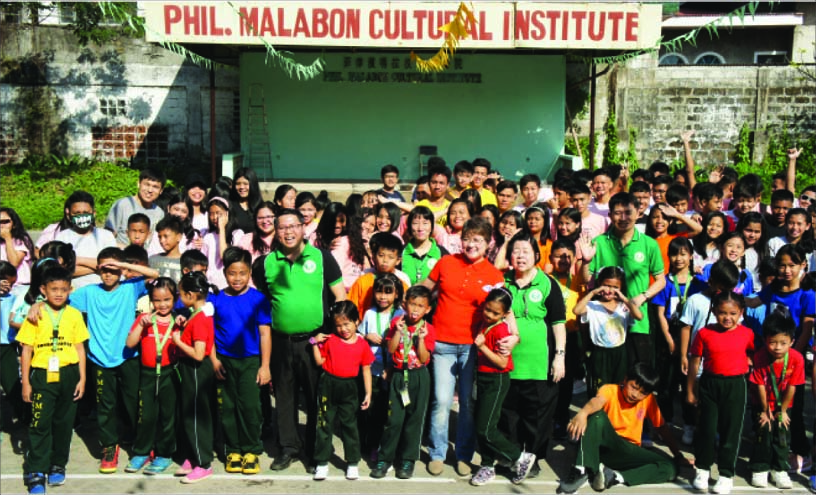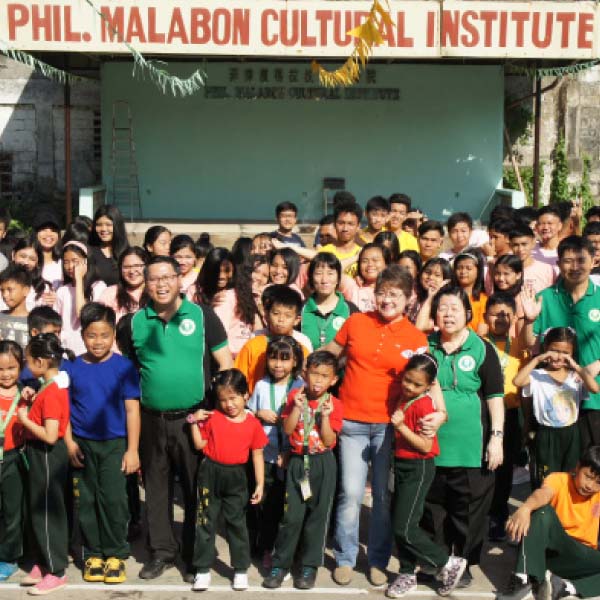
The story of the Philippine Malabon Cultural Institute (PMCI 菲律賓嗎拉汶文化書院), formerly Malabon Chinese School (嗎拉汶華僑小學), reflects the history of Malabon City itself. In recent years, it has struggled to overcome seemingly insurmountable difficulties like perennial flooding but managed to continue to fulfill its mandate of producing outstanding students who became productive citizens of our country.
PMCI marked its 60th anniversary in 2018 with activities which include the induction of its new set of officers and a grand alumni homecoming where school officials, faculty members, alumni and students renewed their commitment to continue to support the education of its students, regardless of race or social status.
School background
PMCI was established in 1958 in Barangay Longos, when Malabon was still a town in Rizal province. The rivers then were still pristine and clean, where small children swim and gather talangka (crablets) and eat them fresh.
Several alumni recalled that they used to pass by the beautiful riverside and many fishponds on their way to school. They enjoyed immensely the cool breeze and the lush foliage of plants and trees. After all, Malabon started as a retreat for friars during the Spanish occupation.
The war reparations and post-war rehabilitation efforts spearheaded a renewed industrialization of the Philippines. During the 1950s, many industries emerged throughout the archipelago, and Malabon was among the chosen areas to get away from congested Manila and Caloocan.
The municipality’s location was strategic because it is between Manila and Bulacan, the pathway to Central Luzon. It attracted businessmen because of the convenience in acquiring raw materials and delivering the products for distribution to the market.
The municipality became a new hub of many Tsinoy industries such as Globe Paper Mill, Candyman, Malabon Soap, Hoc Guan, Hanford, Liwanag Candles and commercial establishments like Malabon Long Life Trading Corp., Malabon Commercial, Super Fine Feed Mills to name a few.
PMCI in retrospect
The growth of Tsinoy-owned businesses increased the number of Tsinoy families, whose offspring needed Chinese-language education. Malabon’s educational institutions were either the public schools, or the St. James Academy, a Catholic school. Chinese schools were in Manila, or the nearest was Northern Rizal Yorklin School.

The idea to found a Chinese school was the brainchild of then Malabon Chamber of Commerce and Industry (MCCI) president Co San (蔡振錦) and was supported by many of his colleagues, mostly pioneer Tsinoy families in Malabon.
The groundbreaking ceremony of the school’s main building was held on Feb. 4, 1957 and classes commenced for elementary levels a year later, on Feb. 6, 1958, with 200 enrollees. Three years later, on March 10, 1961, the kindergarten building (now demolished) was built through the generosity of Ke Eng Chay and Lim Gui Liu. On May10, 1964, Lim Se Keng financed the extension of the main building to house more than 800 students.
In 1971, the new Philippine Constitution provided for the Filipinization of all alien schools. Ferdinand Marcos issued Presidential Decree 176 on April 16, 1973 to implement the Filipinization. Only Filipino citizens could exercise control and management of schools and the word Chinese thus removed from the Filipinized Chinese schools.
Thus, Malabon Chinese School became the Philippine Malabon Cultural Institute. The high school department was established in 1997 under the PMCI board of trustees headed by Manuel Chua Co Kiong as chairman. This time, the school was equipped with computer units, televisions sets and an audio-visual room.
The Marcos years changed not only the school’s structure but it was also a period when the landscape surrounding the school was transformed.
The school used to be surrounded by fishponds and rivers but due to urbanization, the CAMANAVA (Caloocan-Malabon-Navotas-Valenzuela) area was greatly affected. The fishponds were landfilled and converted into residential areas, worsening the perennial flood problem in Malabon.
Challenges to the school
The last two decades saw dwindling enrollment in Chinese schools and PMCI was no exception. One problem is smaller families with fewer offspring. The situation is much worse in Malabon because of the perennial flooding
that encouraged many residents to move to higher grounds.
Notwithstanding the challenges, the institution managed to overcome obstacles and shine academically. It scored a three-year exemption in the National Elementary Achievement Test in the 1990s.
Expansions and reforms were also done, such as hiring experienced teachers from China to enhance the Chinese education, establishing a bilingual high school department in 1997 and the physical expansion of school facilities.
In 1998, PMCI celebrated its 40th anniversary which paved the way to the establishment of PMCI Alumni Association (PMCIAA) in 2002 with Romy Yu as founding president.
The MCCI, PMCI board of trustees and PMCIAA have not wavered in their commitment to support the school. They united the entire PMCI community to ensure that the school will remain standing amidst all odds.
60th anniversary and alumni homecoming
The MCCI, on its 64th founding anniversary, and PMCI board of trustees marked PMCI’s 60th anniversary in a joint celebration held at Gloria Maris Shark’s Fin Restaurant in Pasay City on March 11, 2018. Both MCCI and PMCI board of trustees also inducted their new set officers who were sworn in to office by Domingo Yap, president of Federation of Filipino-Chinese Chambers of Commerce and Industry, Inc.
Malabon City Mayor Antolin Oreta III was the keynote speaker and guest of honor during the event while Malabon City Rep. Federico Sandoval II delivered a congratulatory message.
After months of intense and stressful preparations, PMCIAA celebrated its alma mater’s 60th year with a grand alumni homecoming on Nov. 23, at Pescadores Restaurant in Malabon with Oreta and Sandoval as guests of honor.
Other honored guests included members of the school’s board of trustees, MCCI officers, Chiang Kai-shek College president Dr. Dory Poa (whose father, Poa Bun Po, was a principal of Malabon Chinese School from 1969-1971), a delegation from the Federation of Filipino-Chinese Alumni Associations led by president Jimmy Sy and representatives of other leading Tsinoy organizations.
During dinner, certificates were given to former teachers and officials as tribute for their dedication to their service to the school. Awardees included Consuelo S. Robles, a teacher and English supervisor who served the school for 36 years.
It was a night of reminiscences, entertainment and a fun-filled event.
The highlight of this diamond year celebration was the pledges of financial support from some batches and several sponsors.
The school community, its trustees, faculty, administrators, alumni and students look forward to permanent solutions to the perennial flooding problem that will hopefully reinvigorate the institution and the businesses that continue to support it.





